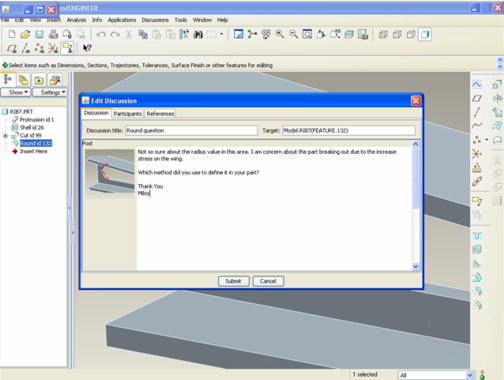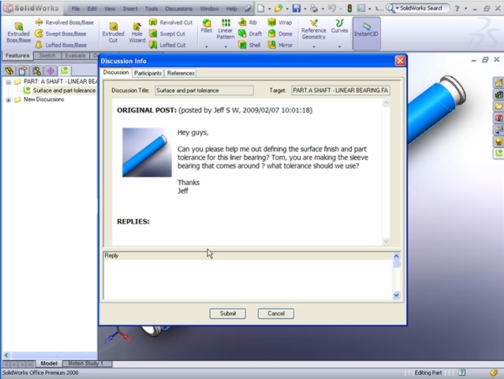Latest News
May 13, 2009
Last week, I hijacked someone’s blog topic (with the original blogger’s blessing).
In my post titled “Product Development in the Post-Twitter Era,” I picked up the discussion started by PTC’s Tom Shoemaker in his post titled “A Day in the Life of Product Development.” In Shoemaker’s imaginary scenario, the fictional engineer, Bob, is equipped with a futuristic product development system. Shoemaker anticipates such a system would send alerts when failures occur, reveal a prototype’s revision history, identify those who’ve worked on the project, and let Bob get in touch with a potential collaborator.
In my post, I explored how Bob might accomplish all of those mentioned above through a patchwork of social networks and file-sharing tools already in existence (like Facebook, Twitter, Flickr, and others).
Let’s add something else to the mix. If Bob’s employer uses SolidWorks or Pro/ENGINEER, he might also consider using Vuuch, a plug-in that lets you initiate, monitor, and manage design discussions right from your CAD environment.

“With Vuuch, you create discussions associated to anything in your design files,” according to the company. “As people reply, you follow the discussion from within your design, you no longer need to search or manage your inbox.”
I think Chris Williams, the founder of Vuuch, may have found a way to inject a dash of social networking in 3D design. On Facebook, some of my friends would occasionally chime in when I post a vacation photo or a status update. Then I start responding, which attracts more comments, which in turn prompts more responses, more comments, more .. (OK, you get the picture).
In the past, these exchanges took place in group emails. As the discussion picked up steam, it became nearly impossible to make head or tail out of the string of responses. Besides, these emails were scattered in my inbox, making it difficult for me to sort them according to relevance as separate threads. (I often found myself doing keyword searches in the text of my messages to dig up what someone had said about a certain topic. But that had obvious limitations too. The search often returned more than what I was looking for.)
For these reasons, I now prefer Facebook’s approach, which gives you a collapsible view of the comment string, attached to the original photo or statement that has prompted it. Looking at Vuuch’s interface in its demo video, I realized that’s how the application manages design discussions. In a recent interview, Vuuch’s Williams said, “Vuuch is about the unstructured. The design process is filled with unstructured activities.”
If you are a programmer or just happen to have a knack for cutting code, you might check out Vuuch’s open API, set to become available soon. “If you are interested in working on a WordPress, PHPBB, or vBulletin add-in, then get in touch with us. Anyone can build Vuuch clients using our Open API,” the company wrote in its blog Vuuch Voice.

Taking the social media integration further, Vuuch is currently developing a feature to let you send posts directly to 3DCAD Forums, Eng-Tips Forums, or other popular online destinations for CAD users and engineers.
“If blogs and forums are not your fancy, then how about a Web 2.0 widget or a Twitter widget?” Vuuch suggested. “[If] you would rather build a JAVA, HTML, or Flash-based widget for Vuuch public discussions, then let us know.”
Among big-name manufacturers exploring the benefits of social media is Proctor & Gamble (P&G). The company’s most recent initiative is the Loads of Hope campaign to promote its Tide detergent brand. Tripple Pundit, a business trend site, reported, “The company flew over a hundred social media experts to Cincinnati headquarters to meet with brand managers, divided them into four teams, and kicked off a fund raising competition via Twitter, blogs, social networks, etc., to drive traffic to one of the four tracking sites (tide1.com, tide2.com, etc.).”
To Bob, the imaginary engineer brought to life by Tom Shoemaker, I’d like to say, “Welcome to product development 2.0.
Subscribe to our FREE magazine, FREE email newsletters or both!
Latest News
About the Author
Kenneth Wong is Digital Engineering’s resident blogger and senior editor. Email him at [email protected] or share your thoughts on this article at digitaleng.news/facebook.
Follow DE





